News
Release of Jason-1, Jason-2 and Envisat annual validation reports, 2010
Those documents present the synthesis concerning validation activities of Jason-1, Jason-2 and Envisat GDRs. They assess the altimeter data quality.
The validation activities assess the data quality: missing and edited, relevant parameters derived from instrumental measurements and geophysical corrections. Analyzes are also focused on cross-calibration to precisely assess parameter discrepancies between missions in order to detect geographically correlated biases, jumps or drifts.
In year 2010, we pointed out particularly that:
- The spatial coverage is excellent for Jason-1, Jason-2 and Envisat missions.
- The performances are good as shown on the monitoring of the standard deviation at crossovers.
<link fileadmin images news mod_actus news_annual_report_j1_ect_x.png download>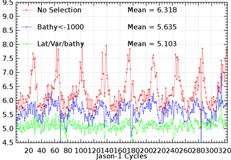 | <link fileadmin images news mod_actus news_annual_report_j1_j2_ect_x.png download>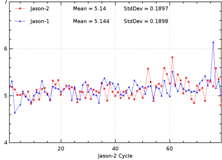 | <link fileadmin images news mod_actus news_annual_report_en_ect_x.png download>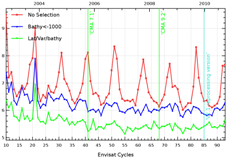 |
|---|---|---|
Crossover standard deviation (cm) for Jason-1, Jason-2 and Envisat. Credits CLS/Cnes/Esa. | ||
- The problems on the strong mispointing on Jason-1 during spring and summer 2010 (due to poor star tracker and gyroscope performances) has been solved by the end of the year following the change of the gyro and the upload of new tables of star tracker.
<link fileadmin images news mod_actus news_annual_report_mispointing_j1.png download>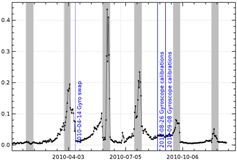 | Daily monitoring of Jason-1 apparent squared misponting (deg2) from waveforms for 2010. Gray stripes indicate periods where Jason-1 is in fix mode. Credits CLS/Cnes. |
|---|
Though Jason-2 radiometer performances are improved especially near coasts, potential stability problems are observed in Jason-2 IGDR product. These potential stability problems are corrected thanks to new ARCS system applied for GDR. Nevertheless these corrections introduce sometimes small jumps and might miss real geophysical evolutions.
This year, sensitivity studies performed on Envisat's Mean Sea Level enabled:
- to show the importance of the gravity field model in the orbit solution, notably on geographical trends.
- to further analyse the wet tropospheric correction stability in order to better quantify the error budget remaining in the MSL estimation.
- to explain around 1mm/year in Envisat drift compared to Jason-1 due to an instrumental correction (linked to the position of the PTR (Point Target Response). The poor resolution of this correction introduced a jump on the data series around september 2008 (see plot) traduced by a 1mm/year effect on the whole data series. The resolution of this parameter will be improved in the V2.1 Reprocessing.
<link fileadmin images news mod_actus news_annual_report_en_ptr.png download>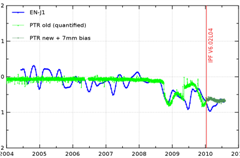 | Difference of PTR (cm) with 2 different resolutions compared to Envisat-Jason-1 SLA difference. Credits CLS/Cnes/Esa. |
|---|
- Mean SSH differences at Jason-2/Jason-1 crossovers are quite homogeneous (a part of a bias of approximatly 7.5 cm). It shows a small regional structures of about 1 cm, especially in southern high latitudes. It is dependant on orbit solutions, as it is strongly reduced when using GSFC orbit solutions for both missions. Though Jason-2 and Envisat are using CNES produced POE (for this study, POE GdrC standard is also used for Envisat), a large east/west bias is observed. This strange behaviour is under investigation.
<link fileadmin images news mod_actus news_annual_report_carto_j1j2.png download>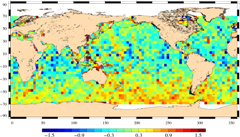 | <link fileadmin images news mod_actus news_annual_report_carto_j2en.png download>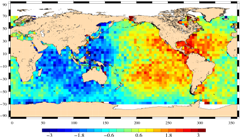 |
|---|---|
Maps of mean of SSH crossovers differences (cm) between Jason-2 and Jason-1 for Jason-2 cycle 1 to 72 using GDR orbit (left) and between Jason-2 and Envisat for Jason-2 cycles 7 to 72 using GDR-C orbit for both missions (right). Credits CLS/Cnes/Esa. | |
A reprocessing of the whole Envisat altimetric mission began in late 2010. Since cycle 93, data are distributed in V2.1 version including: a new precise orbit based on recent Grace data and new ITRF model, new geophysical and instrumental (USO and PTR) corrections, new SSB, updated wet tropo corrections... Refer to Ollivier A, J.F. Legeais, N. Granier, Y. Faugere, F-PAC Calval Team: "<link fileadmin documents calval validation_report en_comp_gdrc_b v2.1_reprocessing_impact_on_altimetric_parameters.pdf download>CalVal status on the Envisat V2.1 reprocessing impact on main altimetric parameters" and validation reports on <link internal-link-new-window>aviso web site
At the end of October 2010 Envisat shifted to its "drifting phase" mode (the orbit is not repetitive anymore) in order to increase its life time by reducing the maneuvers. Converted in km at 50° latitude, the drift is around 7km in 6 cycles whereas around 3.6km were expected. This will therefore be monitrored carefully.
Preliminary results show that Envisat's performances are still very good after the change of orbit exept for the expected slight degradation due to the MSS quality outside of the repeat track.
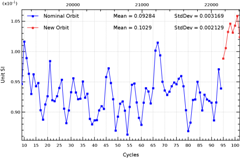 | Standard deviation (dm) of Envisat GDR SLA monitoring. Credits CLS/Cnes/Esa. |
|---|
Further information:
- <link internal-link-new-window>Systematic Validation activties
- <link fileadmin documents calval validation_report j2 annual_report_j2_2010.pdf download>Jason-2 annual validation report 2010
- <link fileadmin documents calval validation_report j1 annual_report_j1_2010.pdf download>Jason-1 annual validation report 2010
- <link fileadmin documents calval validation_report en annual_report_en_2010.pdf download>Envisat annual validation report 2010
- <link internal-link>Mean Sea Level































